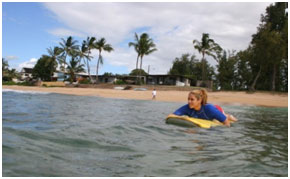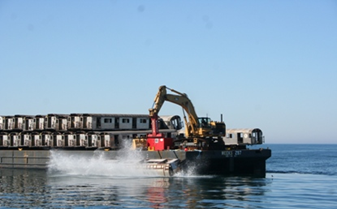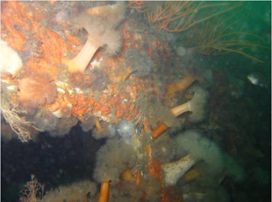The Bounty of the Sea
![]() Each Monday we write about the New England environment and way of life seen through our local perspective. Previous posts
Each Monday we write about the New England environment and way of life seen through our local perspective. Previous posts
By Phil Colarusso
Thousands of silver fish flashed around my head in every direction. The school of pollock seemed to be everywhere at once and their sheer abundance was disorienting. It’s easy to understand how difficult it must be for a predator to pick out individual fish in this incredible moving mass of life.
I’ve only had the pleasure of being enveloped by large schools of fish a few times in my diving career. Even so, today’s schools are typically small compared to historical accounts of fish abundance. Mariners in the 19th century and earlier reported schools streaming past their boats for hours at a time, so they probably had millions of fish. In 2013, it’s rare to find these massive congregations.
We used to believe the bounty of the seas was endless. We’ve since learned that fish, like other natural resources, are finite. Slow declines in abundance can go undetected by fishermen, scientists and the public. But, if these changes continue over a long time, lower levels of abundance become the new normal state.
Scientists have coined the term “shifting baselines” to describe this phenomenon. Each generation of scientists regards the state of the natural world during their career as the normal state, but in reality, small changes over multiple generations result in dramatic differences. The ocean that I swim in now is a very different place than the ocean of Jacques Cousteau in the 1960s.
The logical question to ask is: “Where did the bounty go?” Unquestionably, a large percentage of it went into fishermen’s nets to feed the world’s growing human population, but that’s not the only thing that’s going on. The oceans are part of a system with a large number of interlocking components involved in an elaborate balancing act. A significant change in one piece inevitably has implications (both positive and negative) for others. For example, in New England, the overfishing of cod resulted in skate and dogfish populations exploding. Simply stopping the fishing of cod may not be sufficient to restore populations to their historic levels: cod fishing ended on the Canadian side of Georges Bank more than a decade ago with little population recovery.
However, while my oceans are different than the oceans of Cousteau, they’re still special places. As I was surrounded by pollock, it was impossible not to be filled with hope.
More information about the work of EPA’s scientific divers.
About the author: Phil Colarusso is a marine biologist in the Coastal and Ocean Protection Section of EPA New England, and is an avid diver. He’s living the dream in Wenham with wife JoAnn, two kids, dog and white picket fence.







 Have you ever wondered what you could be when you grow up? How about working for EPA? Check out one of EPA’s ocean scientists at work: Renee Searfoss. Learn about her job and how she first became inspired to become an EPA scientist on EPA’s You Tube channel.
Have you ever wondered what you could be when you grow up? How about working for EPA? Check out one of EPA’s ocean scientists at work: Renee Searfoss. Learn about her job and how she first became inspired to become an EPA scientist on EPA’s You Tube channel. The summer beach season is in full swing!
The summer beach season is in full swing! Do you ride a subway to work? Do you know anyone who lives in a city where subways or other rail mass transit systems are used? Subway and rail mass-transit systems are a very efficient and economical way to travel in a city. Some of the largest mass transit systems in the U.S. are in the Mid-Atlantic and New England Regions of the EPA: Southeastern Pennsylvania Transportation Authority (SEPTA), Washington Metropolitan Area Transportation Authority (WMATA), and Metropolitan Transportation Authority (MTA). Each of these transportation agencies utilizes dozens of subway and regional rail cars, replacing their fleets as they age.
Do you ride a subway to work? Do you know anyone who lives in a city where subways or other rail mass transit systems are used? Subway and rail mass-transit systems are a very efficient and economical way to travel in a city. Some of the largest mass transit systems in the U.S. are in the Mid-Atlantic and New England Regions of the EPA: Southeastern Pennsylvania Transportation Authority (SEPTA), Washington Metropolitan Area Transportation Authority (WMATA), and Metropolitan Transportation Authority (MTA). Each of these transportation agencies utilizes dozens of subway and regional rail cars, replacing their fleets as they age. EPA completed its second survey of Delaware’s Red Bird reef site on June 2 – 9. I was one of fifteen EPA scientist/divers who surveyed the condition and function of the subway car artificial reef. This was my first dive survey since joining EPA’s Dive Team in May of 2010, and it was an exciting experience. At first glance you may think that such dives are easy – after all, how difficult could it be to dive and look at a bunch of subway cars? The reality is that these cars were sunk in 85-95 feet of water, the temperature at the bottom is 48º F, and the visibility was only about 10 feet in any direction. This means that first we had to locate individual cars from the surface and dive to them. Once anchored to the car, we used a wreck reel and swam in each direction to find other cars, all without losing track of the anchor line. Having been through EPA Diver Training, I found that swimming in such an environment wasn’t too difficult, but it definitely took some getting used to. Throughout the week-long survey, the team collected information on the structural condition of the cars, percent cover of encrusting organisms, and height of aquatic growth on the cars at six specific reef locations. The team utilized video and still photos to document findings.
EPA completed its second survey of Delaware’s Red Bird reef site on June 2 – 9. I was one of fifteen EPA scientist/divers who surveyed the condition and function of the subway car artificial reef. This was my first dive survey since joining EPA’s Dive Team in May of 2010, and it was an exciting experience. At first glance you may think that such dives are easy – after all, how difficult could it be to dive and look at a bunch of subway cars? The reality is that these cars were sunk in 85-95 feet of water, the temperature at the bottom is 48º F, and the visibility was only about 10 feet in any direction. This means that first we had to locate individual cars from the surface and dive to them. Once anchored to the car, we used a wreck reel and swam in each direction to find other cars, all without losing track of the anchor line. Having been through EPA Diver Training, I found that swimming in such an environment wasn’t too difficult, but it definitely took some getting used to. Throughout the week-long survey, the team collected information on the structural condition of the cars, percent cover of encrusting organisms, and height of aquatic growth on the cars at six specific reef locations. The team utilized video and still photos to document findings.
 Each week we write about the science behind environmental protection.
Each week we write about the science behind environmental protection.  Seagrasses are underwater marine flowering plants that have long, narrow leaves. Because they photosynthesize, seagrasses must grow in shallow water where light penetrates. Most of the light required for these plants disappears below 30 feet.
Seagrasses are underwater marine flowering plants that have long, narrow leaves. Because they photosynthesize, seagrasses must grow in shallow water where light penetrates. Most of the light required for these plants disappears below 30 feet.